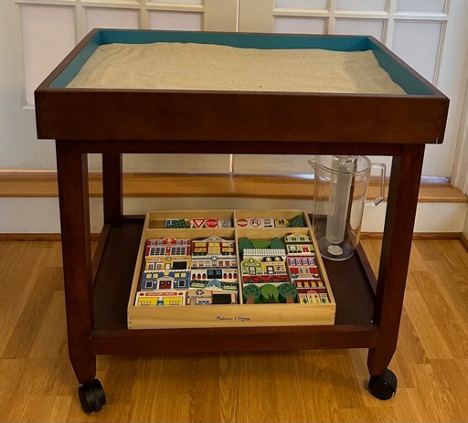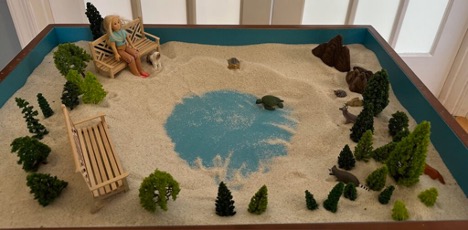
Expressing What Words Cannot: Sandtray Therapy
Sandtray therapy offers adults a powerful, non-verbal approach to healing that can reach places that talk therapy alone sometimes cannot access. This gentle yet profound therapeutic technique allows you to create miniature worlds using sand, a specialized tray, and a collection of figurines and objects.
In my practice, sandtray therapy serves as both a standalone approach and a perfect complement to IFS and EMDR work for adult clients. The process is simple, yet remarkably revealing:
You select items that draw your attention from my diverse collection of miniatures.
These objects are arranged in the sand to create a three-dimensional representation of your inner experience.
The completed sandtray becomes a tangible expression of unconscious material, allowing us to work with it directly.
No artistic skill is required – the process is intuitive and guided by your own inner wisdom.

Sandtray therapy is particularly effective for:
Expressing emotions or experiences that feel beyond words.
Accessing pre-verbal or deeply stored memories.
Working through complex trauma in a contained, manageable way.
Giving form to internal conflicts or relationship dynamics.
Developing greater self-awareness and emotional integration.
Many clients find that sandtray work provides breakthrough moments in their therapeutic journey, revealing connections and insights that might otherwise remain hidden. The visual and tactile nature of this approach engages different parts of the brain than verbal therapy, often leading to deeper and more lasting change.

Frequently asked questions
Sandtray therapy is remarkably versatile and effective for a wide range of concerns, including trauma, relationship patterns, life transitions, grief, and identity exploration. It’s particularly helpful when words feel inadequate to express complex emotions or experiences. Many clients find that sandtray work creates breakthroughs in their therapy journey by accessing material that talk therapy alone hasn’t reached.
Not at all. Many clients benefit from an integrated approach that draws from all three modalities, based on your specific needs and preferences. We might use EMDR for processing specific traumatic memories, IFS to work with protective parts, and sandtray to explore themes or patterns that are difficult to verbalize. We’ll collaborate to determine which approaches feel most helpful for you at different points in your therapy journey.
While these three modalities form the foundation of my practice, I integrate other approaches based on each client’s unique needs. These include Motivational Interviewing (particularly effective for addiction recovery), Cognitive Behavioral Therapy (CBT) techniques, and supportive counseling. This flexible approach allows me to tailor therapy to your specific circumstances, preferences, and goals, recognizing that healing isn’t one-size-fits-all.